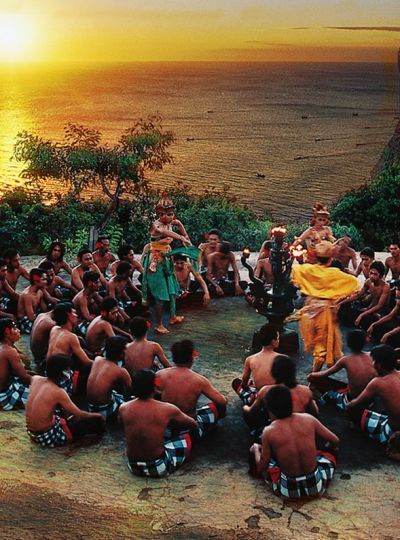Balinesische Kultur
Die Insel der Götter
Die balinesische Kultur ist komplex – eine einzigartige Kombination aus Spiritualität, Religion, Tradition und Kunst. Anthropologen glauben, dass die Balinesen von den alten Chinesen, Indern und Arabern aus dem Westen abstammen, sowie von anderen Völkern, die direkt oder über Java nach Bali kamen.
Die im ersten Jahrhundert nach Christus eingeführte hinduistische Kultur durchdringt noch immer das gesamte balinesische Leben und bringt eine kontinuierliche Abfolge von Festen und Zeremonien das ganze Jahr über mit sich, während sie der Gesellschaft eine klare Struktur verleiht. Wo immer Sie sich auf Bali befinden, werden Sie von den lebhaften Farben der Batik-Kostüme, den Blumen- und Opfergaben aus Früchten sowie den zahlreich verzierten Tempeln, die einer Vielzahl von Göttern gewidmet sind, begeistert sein. Es gibt ständige Feierlichkeiten des Kreislaufs von Geburt, Tod und Wiedergeburt sowie Hochzeiten, Kindheit, Ahnenverehrung und viele weitere bedeutende Lebens- und Gemeinschaftsereignisse.
Die traditionelle balinesische Kunst ist eine Erweiterung der balinesischen Hindu-Religion, wobei alle alten Kunstformen die heiligen Schriften des Ramayana und Mahabharata hervorheben. Die Insel verfügt über eine reiche Tradition von Handwerkern und ist berühmt für ihre Holzschnitzereien, Malereien, Gold- und Silberschmiedekunst, Batikstoffe, Tänze und Dramen. In den 1930er und 1940er Jahren kam es zu einem kreativen Aufschwung in der balinesischen Kunst, insbesondere in der Malerei und Holzschnitzerei, der vor allem westlichen Einflüssen zugeschrieben wird.
Bali ist eine patriarchalische Gesellschaft, in der die Familie die grundlegende Einheit bildet. Ein hinduistisches Kastensystem bestimmte einst streng die gesellschaftlichen Interaktionen. Heute spielt die Abgrenzung zwischen Kasten in der modernen balinesischen Gesellschaft eine untergeordnete Rolle, da Bildung und soziale Aufstiegsmöglichkeiten nun allen offenstehen. Dennoch bleibt der Respekt vor familiären Ursprüngen in der Art und Weise, wie Menschen miteinander umgehen, stets präsent. Die erste Frage bei einer Vorstellung dient dazu, die Kaste zu bestimmen und entsprechend die Anredeform zu wählen. Während eine Eheschließung zwischen Kasten früher mit dem Tod bestraft werden konnte, ist sie heute weitgehend akzeptiert.


